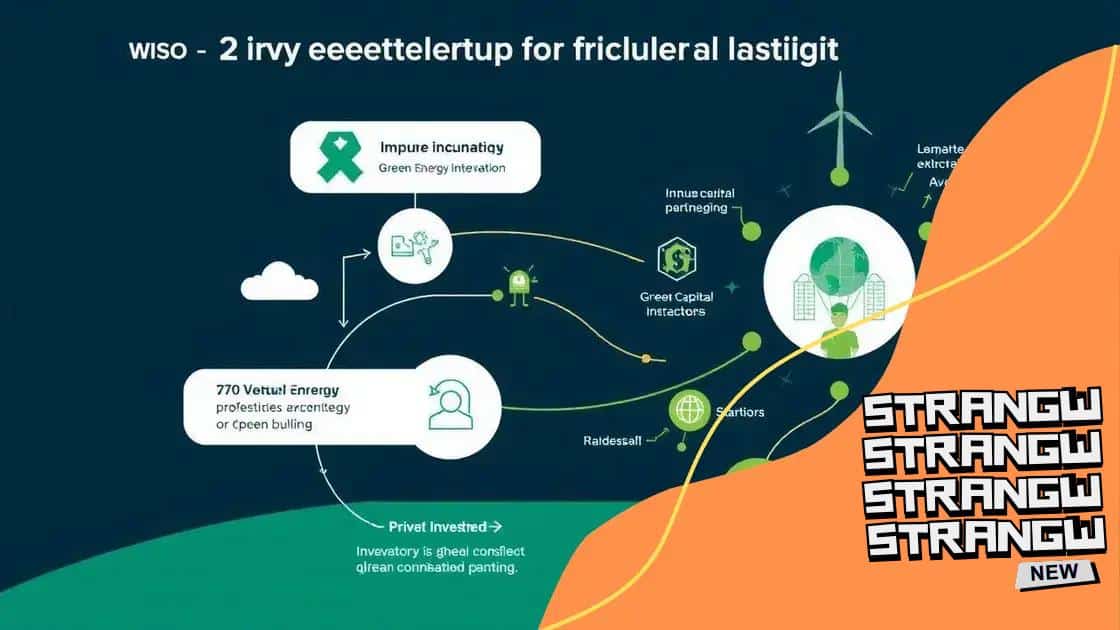Green energy technology funding trends you need to know

Green energy technology funding trends show increased government support, rising private investments, and a focus on innovative financing models, driving growth and innovation in the renewable energy sector.
Green energy technology funding trends are reshaping the landscape of sustainable investments. Have you noticed how these changes influence innovation and the market? Let’s dive into what this means for our future.
Current funding sources for green energy technology
Understanding the current funding sources for green energy technology is essential for anyone interested in the future of sustainable energy. With the growing urgency to combat climate change, investors and governments are increasingly looking to support clean technology initiatives.
One of the primary funding sources comes from government grants. These funds are designed to support research, development, and deployment of green technologies. Many countries have established programs to provide financial assistance to companies working in renewable energy.
Private Investments
Another significant source is private investment. Venture capitalists and angel investors are beginning to focus on green energy startups. They see the potential for not just environmental benefits but also substantial financial returns.
- Growing interest in sustainable business models
- Long-term profitability in renewable sectors
- Technological advancements attracting funding
Moreover, crowdfunding has emerged as an innovative way for startups to raise capital. Platforms dedicated to green projects allow individuals to invest small amounts, supporting initiatives they believe in. This method has democratized funding in the clean energy sector, enabling more people to participate.
International organizations are also key players. They provide loans and grants to developing countries, helping them to adopt clean energy solutions. This funding often comes with the goal of reducing carbon emissions and promoting sustainable development.
Corporate Sponsorship
Many corporations are investing in green technology through sponsorship and partnerships with startups. In doing so, they not only enhance their public image but also contribute to innovative solutions that align with their sustainability goals.
As the demand for green energy sources continues to grow, the diversity of funding will expand. Understanding these funding sources allows stakeholders to navigate the complex landscape and capitalize on the opportunities available in green technology.
The role of government incentives in funding
The role of government incentives in funding green energy technology is crucial as they drive innovation and support the shift towards sustainable practices. These incentives can take various forms, including tax credits, grants, and subsidies that lower costs for developers and investors.
One important type of incentive is the tax credit, which provides a reduction in taxes owed, making it more appealing for companies to invest in renewable energy projects. For instance, the Investment Tax Credit (ITC) allows investors to deduct a significant percentage from their federal taxes for solar energy investments.
Grants and Subsidies
In addition to tax credits, grants and subsidies are vital resources for emerging technologies. They directly fund research and development efforts, which are essential for advancing new green technologies. By covering part of the costs, these incentives encourage startups to pursue innovative solutions.
- Grants can help finance pilot projects.
- Subsidies support lower production costs for renewable energy.
- Government programs often target specific technologies, such as wind or solar.
Moreover, government incentives can create a competitive market for green energy. When the government shows support, it attracts more private investors who wish to capitalize on these opportunities. The presence of such funding initiatives not only encourages the development of renewable energy projects but also demonstrates a commitment to environmental sustainability.
Additionally, states and local governments may implement their own incentive programs to further boost green energy initiatives. These local incentives can be tailored to meet the specific needs and capabilities of communities. They often work in conjunction with federal programs, amplifying the support available for projects.
Impact of private investment on innovation

The impact of private investment on innovation in green energy technology is significant. These investments not only provide essential funding but also stimulate new ideas and practices in the industry. When private investors back renewable energy projects, they often bring with them expertise and resources that can drive technological advancement.
In many cases, private investment acts as a catalyst for innovation. Investors look for companies that can develop cutting-edge solutions, creating a competitive environment. This competition encourages businesses to improve their products and services, leading to advances in efficiency and effectiveness.
Venture Capital and Startups
Venture capital plays a crucial role in the growth of startups focused on green tech. These firms often lack the financial resources needed for large-scale projects. By tapping into venture capital, they can develop their technologies and bring them to market.
- Venture capitalists identify promising technologies.
- They provide funds for research and product development.
- Private funds can accelerate the commercialization of innovative solutions.
Moreover, private investment often comes with fewer strings attached than government funding. Investors typically allow companies more freedom to experiment and take risks, which is essential for fostering creativity and innovation. This flexibility can lead to groundbreaking breakthroughs that might not happen under more restrictive funding conditions.
As private investors become more involved in green energy, they often influence industry trends. Their investment choices can highlight which technologies are on the verge of wider acceptance. This guidance can help direct research efforts and funding towards the most promising innovations.
Collaboration with Corporations
Partnerships between startups and larger corporations also illustrate the impact of private investment. These collaborations can leverage the strengths of established companies while supporting innovative startups. This synergy creates an environment where new ideas can flourish and contribute to the overall advancement of green technology.
Trends in international green energy funding
Understanding the trends in international green energy funding is vital as countries around the world accelerate their transition to renewable energy sources. These trends reflect an increasing recognition of the importance of sustainable practices in combating climate change.
One notable trend is the rise of global partnerships aimed at financing green energy projects. Countries are collaborating through various agreements to pool resources and share technology. This cooperative approach enhances the ability to tackle larger projects and promotes innovation in green energy technology.
Increased Investment from Developing Nations
Another trend involves increased investment from developing nations as they seek sustainable solutions. These countries recognize that renewable energy can drive economic growth while reducing dependence on fossil fuels. As a result, they are creating policies that attract foreign investment in clean technologies.
- Developing nations are prioritizing solar and wind energy projects.
- Many are seeking foreign expertise and capital to build infrastructure.
- International funding agencies are increasingly focusing on these regions.
Moreover, there is a shift towards innovative financing models such as green bonds. These bonds provide a way for investors to fund environmentally friendly projects while earning returns. Various international organizations are now issuing green bonds to finance renewable energy developments, significantly contributing to the global market.
Focus on Technology Transfer
International funding is also concentrating on technology transfer. Wealthier nations and organizations are increasingly investing in knowledge-sharing initiatives, helping developing countries implement renewable technologies. This trend is essential for creating a more sustainable global energy landscape.
Through various funding initiatives, countries are starting to realize the importance of aligning their economic goals with environmental priorities. This alignment brings about a more integrated approach to energy production, ensuring a sustainable future for generations to come.
Future predictions for green technology investments
The future predictions for green technology investments look highly promising as the world increasingly prioritizes sustainability. Experts expect this sector to experience robust growth driven by innovations and changing regulations worldwide.
One of the most significant trends is the anticipated increase in government support. As countries commit to reducing carbon emissions, they are likely to foster environments conducive to clean energy investments. This support can include tax incentives, subsidies, and grants aimed at encouraging businesses to develop sustainable technologies.
Emerging Technologies
Moreover, innovations in renewable energy technologies are expected to attract substantial investment. Solar energy, wind power, and energy storage solutions are likely to lead the way. These technologies will draw the attention of investors looking for cutting-edge opportunities.
- Solar panel efficiency continues to improve.
- Advancements in battery storage increase the viability of renewable sources.
- Emerging solutions like green hydrogen are becoming more feasible.
Additionally, sustainability practices in traditional industries are also predicted to attract funding. Corporations are increasingly recognizing that investing in sustainable technologies can enhance their business models. For example, many are transitioning to circular economy practices, reducing waste while increasing efficiency.
Investment from Private Sectors
Private investors are poised to play a crucial role in the growth of green technology. As public awareness of climate issues continues to rise, there will likely be a shift in investor priorities. More capital is expected to flow into green funds, which focus exclusively on sustainable investments.
Incorporating ESG (Environmental, Social, and Governance) criteria will also guide future investments. Companies that prioritize sustainability in their operations may gain a competitive edge, making them more appealing to investors.
FAQ – Frequently Asked Questions about Green Energy Technology Funding
What are the main sources of funding for green energy projects?
Funding for green energy projects mainly comes from government grants, private investments, and international collaborations aimed at promoting renewable technology.
How do government incentives impact green energy investments?
Government incentives provide financial support in the form of tax credits and grants, making it easier for companies to invest in and develop green technologies.
Why is private investment important for innovation in green technology?
Private investment stimulates innovation by providing the necessary capital for startups to develop cutting-edge solutions and by fostering a competitive market.
What trends are shaping the future of green technology investments?
Trends include increased government support, rising private investments, the introduction of innovative financing models, and a focus on sustainability in traditional industries.





